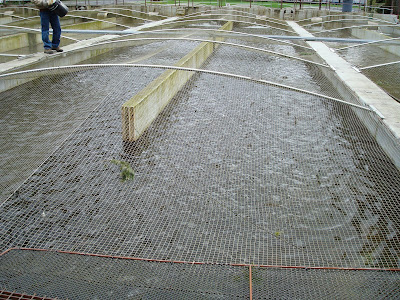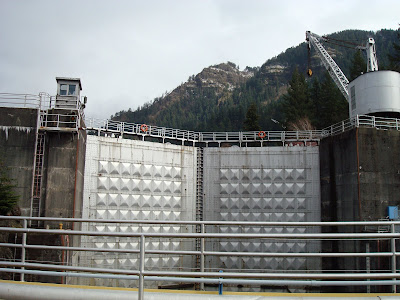 We had a lazy Sunday afternoon so we decided to check out some local attractions. About a 40 minute drive east of Portland is the Bonneville Dam and Fish Hatchery in the picturesque Columbia Gorge. It had been raining hard all morning so the waterfalls were gushing. Em rolled down the window and caught a few waterfall shots on our drive to the dam.
We had a lazy Sunday afternoon so we decided to check out some local attractions. About a 40 minute drive east of Portland is the Bonneville Dam and Fish Hatchery in the picturesque Columbia Gorge. It had been raining hard all morning so the waterfalls were gushing. Em rolled down the window and caught a few waterfall shots on our drive to the dam.

 ....and an old favorite: Multnomah Falls
....and an old favorite: Multnomah Falls(mentioned in an earlier post, where we hiked to the top)...
OK, on to the fishery. This location literally raises millions of salmon each year which are later released into the Columbia River. The fish make their way out to the ocean where they live for 2-3 years before returning up the same river to their former birthplace to spawn and die. Here, they catch the spawning fish and collect the eggs for incubation to ensure a successful population of salmon.
 After the eggs hatch, the small fish are called sac-fry. They resemble an embryo and live off of a yolk sac attached to their ventral side. After they get a little bigger, they start to resemble salmon and are transferred to a series of graduated tanks where they are hand fed hourly.
After the eggs hatch, the small fish are called sac-fry. They resemble an embryo and live off of a yolk sac attached to their ventral side. After they get a little bigger, they start to resemble salmon and are transferred to a series of graduated tanks where they are hand fed hourly.  They also have some rainbow trout transferred from another hatchery. See the end of this blog entry for a video of the feeding frenzy when you throw in a handfull of food pellets.
They also have some rainbow trout transferred from another hatchery. See the end of this blog entry for a video of the feeding frenzy when you throw in a handfull of food pellets. Here's Em with her new friend, "Herman" the sturgeon.
Here's Em with her new friend, "Herman" the sturgeon. He is about 11 ft long, 500lbs, and 70 years old.
 The Bonneville Dam
The Bonneville DamThe dam has several impressive features. First is two sets of locks that allow boats to pass through the dam. The locks are large enough to allow barges to pass, yet free and accessible to recreational boaters.
 The gates of the locks.
The gates of the locks.The second impressive feature of this dam is that not only can boats pass, but salmon also have a passage through the dam. The dam was constructed as to not disturb the pilgrimage of the salmon up the river during their spawning. How very Portland. (BTW, they don't salt the icy winter roads in Portland because the salt runoff can harm the salmon.) The "fish ladders" consist of 60 one foot high steps that the salmon can swim up safely. I gotta remember to come back in the fall to witness such a spectacle.
 Fish Ladders
Fish LaddersThe third impressive feature of the dam is the hydroelectric power plant. In an age of green this and green that, we often forget that many of us have been using hydroelectric power since the New Deal.
 Overhead is the massive 300 ton crane that they use to move the parts of the turbines.
Overhead is the massive 300 ton crane that they use to move the parts of the turbines.Video of the trout feeding frenzy:









































